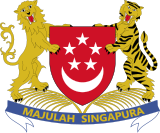
Back Kabinet Singapura ID Kabinet Singapura Malay Cabinet of Singapore SIMPLE Уряд Сінгапуру Ukrainian Nội các Singapore Vietnamese 新加坡内阁 Chinese
| Current: Fifth Lee Hsien Loong Cabinet | |
| Cabinet overview | |
|---|---|
| Formed | 5 June 1959 |
| Type | Decision making |
| Jurisdiction | Government of Singapore |
| Headquarters | Singapore |
| Cabinet executives | |
| Website | www.pmo.gov.sg |
| This article is part of a series on |
 |
|---|
|
|
The Cabinet of Singapore forms the executive branch of the Government of Singapore together with the President. It is led by the Prime Minister who is the head of government. The prime minister is a Member of Parliament (MP) appointed by the president who in the president's judgment is likely to command the confidence of the majority of the Members of Parliament (MPs). The other Ministers in the Cabinet are Members of Parliament appointed by the president acting in accordance with the advice of the prime minister. Ministers are prohibited from holding any office of profit and from actively engaging in any commercial enterprise.
The Cabinet has the general direction and control of the Government and is collectively responsible to Parliament. It also has significant influence over lawmaking. Ministers may be designated by the prime minister to be in charge of particular ministries, or as Ministers in the Prime Minister's Office. Singapore's ministers are the highest paid in the world. Prior to a salary review in 2011, the prime minister's annual salary was S$3.07 million, while the pay of ministerial-level officers ranged between S$1.58 million and S$2.37 million.[1] On 21 May 2011, a committee was appointed by the prime minister to review the salaries of the prime minister as well as the president, political appointment holders, and Members of Parliament.[2] Following the recommended wage reductions by the committee which were then debated and subsequently accepted in Parliament, the prime minister's salary was reduced by 36% (includes the removal of his pension) to S$2.2 million.[1] Nonetheless, the prime minister remains the highest-paid political leader in the world.[3]
The earliest predecessor of the Cabinet was the Executive Council of the Straits Settlements, introduced in 1877 to advise the Governor of the Straits Settlements. It wielded no executive power. In 1955, a Council of Ministers was created, made up of three ex officio Official Members and six Elected Members of the Legislative Assembly of Singapore, appointed by the governor on the recommendation of the leader of the house. Following the general elections that year, David Saul Marshall became the first Chief Minister of Singapore. Constitutional talks between Legislative Assembly representatives and the Colonial Office were held from 1956 to 1958, and Singapore gained full internal self-government in 1959. The governor was replaced by the Yang di-Pertuan Negara, who had power to appoint to the post of prime minister the person most likely to command the authority of the Assembly, and other ministers of the Cabinet on the prime minister's advice. In the 1959 general elections, the People's Action Party (PAP) swept to power with 43 out of the 51 seats in the Assembly, and Lee Kuan Yew became the first Prime Minister of Singapore. The executive branch of the Government of Singapore remained unchanged following Singapore's merger with Malaysia in 1963, and subsequent independence in 1965.
Following the 2020 general election, a Cabinet reshuffle took place on 27 July 2020 for the "4G" leaders to experience different ministries with 37 political office holders, the same number as the previous Cabinet. Heng Swee Keat was assigned an additional role as Coordinating Minister for Economic Policies while maintaining his other appointments as Minister for Finance and Deputy Prime Minister.
Gan Kim Yong, Ong Ye Kung, Josephine Teo, Lawrence Wong, S. Iswaran and Chan Chun Sing were reshuffled into new portfolios as Minister. Tan See Leng was appointed as Minister for Manpower after Heng Swee Keat ruled himself out as the PAP's 4G leader and the next prime minister. While Lee Hsien Loong, Teo Chee Hean, Tharman Shanmugaratnam, Ng Eng Hen, Vivian Balakrishnan, Grace Fu and K. Shanmugam retained their portfolios with no new appointments. Indranee Rajah was also reshuffled into a new ministry as second minister while maintaining her role as Minister in the Prime Minister's Office as of 15 May 2021.
Maliki Osman and Edwin Tong were both promoted to a minister position. Tan See Leng was newly appointed into the cabinet as both a minister and second minister.[4]
On 6 June 2022, Prime Minister Lee Hsien Loong announced his new Cabinet line-up and other political appointments on 6 June 2022. These changes will take effect from 13 June 2022. Lawrence Wong will be promoted to Deputy Prime Minister. He will be the Acting Prime Minister in the absence of the Prime Minister and will continue as Minister for Finance.
Tan Kiat How, Chee Hong Tat were reshuffled to a new ministry as senior minister of state. Eric Chua, Baey Yam Keng and Rahayu Mahzam will be promoted and appointed to Senior Parliamentary Secretary. Koh Poh Koon will be appointed Senior Minister of State.
Sun Xueling and Desmond Tan will be appointed Minister of State and Minister of State in the Prime Minister's Office respectively.
- ^ a b "White Paper - Salaries for a Capable and Committed Government". Public Service Division. 10 January 2012. Archived from the original (PDF) on 7 May 2015. Retrieved 1 January 2016.
- ^ "Committee to review salaries of the President, Prime Minister and Political Appointment Holders" (Press release). Prime Minister's Office. 22 May 2011. Archived from the original on 5 March 2016. Retrieved 15 April 2020.
- ^ Mathew, Jerin (28 March 2015). "Singapore PM Lee Hsien Loong remains highest paid country leader with $1.7m annual salary". International Business Times. Retrieved 1 January 2016.
- ^ "PM Lee announces new Cabinet; 6 office holders promoted, 3 retirements". CNA. Archived from the original on 25 July 2020. Retrieved 26 July 2020.